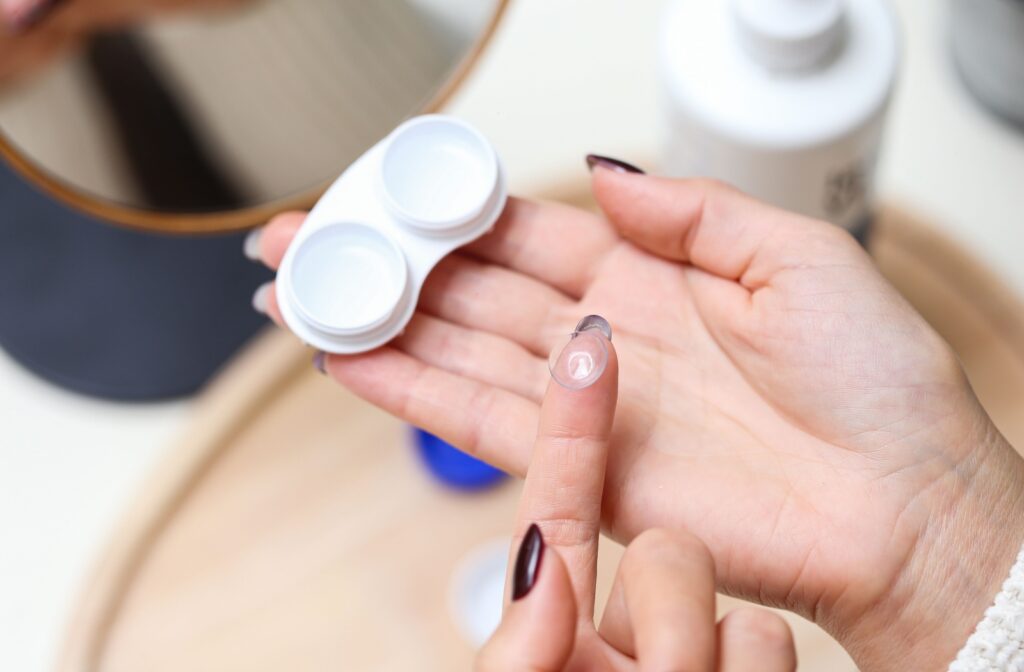Napping with your contact lenses may feel tempting. But before you settle into your afternoon shut-eye, think again. Wearing your contact lenses while you sleep or nap is dangerous, raising the risk of eye infections and discomfort.
Sleeping with contacts puts wearers at risk of complications, such as keratitis. But if you accidentally fall asleep with your contact lenses, there are things you can do to reduce your risk. You can also learn how to recognize signs of an eye infection so you can seek emergency care if needed.
Napping in Contact Lenses: What Happens
Your cornea is a transparent, dome-shaped structure that acts as a “windshield” for your eyes, protecting them against dust and germs in the environment. It also helps you focus. However, corneas require adequate moisture and oxygen to effectively protect your eyes.
Because contact lenses rest directly on top of your eye, they can reduce moisture and oxygen. This effect is more pronounced when you sleep. Therefore, sleeping with contact lenses puts you at higher risk of eye infections because it keeps your cornea from working properly.
Complications Associated with Sleeping in Contact Lenses
Sleeping with your contacts in puts you at risk of complications that can harm your cornea.
Keratitis
Keratitis refers to inflammation of the cornea. Depending on the cause, there are several types of infectious keratitis:
- Bacterial keratitis: This type of keratitis is caused by bacteria. People who use extended-wear contact lenses, are immunocompromised, or have experienced a recent eye injury are at increased risk. Bacterial keratitis can lead to corneal scarring if left untreated.
- Fungal keratitis: This type of keratitis is more common in tropical and temperate areas. Fungal keratitis requires prompt treatment, as it can rapidly progress to blindness if left untreated.
- Acanthamoeba keratitis: As its name suggests, this type of keratitis involves an amoeba that can be found in tap water, lakes, rivers, and pools. Acanthamoeba keratitis can be treated with medicated eye drops, but in serious cases, surgery may be required.
Corneal Abrasion & Corneal Ulcers
The American Academy of Ophthalmology (AAO) reports a case where a 59-year-old man who slept in his contact lenses developed a corneal abrasion, and then later a corneal ulcer. Here’s what these conditions mean:
- Corneal abrasion refers to injury (such as scratches) to the cornea’s surface. This can happen if you wear poorly fitted contact lenses, have dry eye, and wear contacts, or handle your contacts too aggressively when removing or putting them in. While corneal abrasions are often minor, more serious injuries can lead to keratitis or corneal ulcers.
- Corneal ulcers are considered medical emergencies. These are sores on your eye and, left untreated, can lead to vision loss. Symptoms include redness, pain, or inflamed eyelids. You may also feel as though there is something in your eye or experience light sensitivity, blurry vision, or excessive tearing. Sometimes, there is a white or gray smudge on the cornea, but this isn’t always visible. If you think you may have a corneal ulcer, see a healthcare provider right away.
Dry Eye & CLARE
Serious complications aside, napping with your contact lenses can simply lead to discomfort. Contact lenses absorb moisture, and sleeping with them may lead to dry eye. Dry eye isn’t just uncomfortable; this condition can also damage your cornea.
Another possible complication is contact-lens-induced red eye (CLARE). This condition usually resolves if you stop wearing contact lenses for a while.

What About Contact Lenses Designed for Overnight Wear?
There are indeed some types of contact lenses designed for overnight wear, such as orthokeratology (ortho-k) contact lenses and extended-wear contact lenses. But, make sure you understand the wear schedule for your personal set of contacts. Ask your optometrist if you have any doubts. Your optometrist should assess your eye health and recommend a replacement schedule that fits your needs.
What If You Accidentally Fall Asleep with Contact Lenses?
Despite the dangers of sleeping with contact lenses, the reality is it’s a common occurrence. According to one study, roughly one-third of people who wear contact lenses reported that they slept with them.
If you accidentally fall asleep with your contact lenses, don’t panic. After all, nobody is perfect! But do take the following steps to help prevent complications:
- Take your contacts out as soon as possible.
- If removing your contacts is difficult, don’t be forceful. Instead, instill a few drops of artificial tears, wait 5–10 minutes, and then try removing the lenses again.
- Give your eyes a break. Wear regular eyeglasses for a full day and pay attention to any symptoms of eye infections. Contact your optometrist if you have any concerns.
Signs of a Contact Lens-Related Eye Infection
It helps to know how to recognize signs of a contact lens-related eye infection so you can get help as soon as possible. Here are a few things to look out for:
- Redness or pain
- Sensitivity to light
- Blurry vision
- Excessive tears
- Discharge
- The sensation that something is stuck in your eye
Eye Care in San Diego
If you take care of your contact lenses, keep them clean, and avoid wearing them while you sleep, you can reduce your risk of experiencing an uncomfortable complication.
Want to learn more about contact lenses or get a contact lens fitting in San Diego? Visit Total Vision Rancho Bernardo. We would be happy to answer your questions, discuss your options, and teach you how to properly care for and wear your contacts. Book an appointment today.



